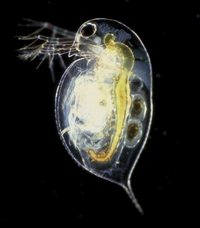
Photo from wikipedia
Daphnia are trophically important, common zooplankton in lakes and ponds worldwide, and hence have become a significant model system in ecology and evolutionary biology. Daphnia have conspicuous eyes that confer… Click to show full abstract
Daphnia are trophically important, common zooplankton in lakes and ponds worldwide, and hence have become a significant model system in ecology and evolutionary biology. Daphnia have conspicuous eyes that confer both fitness benefits and costs, though little is known about the functional capabilities of Daphnia vision. We sought to determine whether free-swimming Daphnia exhibit an optomotor response, a reflexive behavior present in many animals that could be used in studies of visual function. Optomotor responses are movements that allow an individual to track motion of the surrounding environment and thus stabilize its visual field. We constructed an apparatus that rotates a striped drum around Daphnia, while allowing an observer to quantify swimming behavior. Across a range of angular stripe widths and rotational speeds, we demonstrate that Daphnia have an optomotor response composed of at least two distinct behaviors. Our results suggest Daphnia could use vision for predator avoidance in some circumstances, but could not see other Daphnia individuals beyond more than a few millimeters, or food particles at all. We discuss how the optomotor response may be used to study visual function in Daphnia to better understand visually mediated ecological interactions.
Journal Title: Journal of Plankton Research
Year Published: 2018
Link to full text (if available)
Share on Social Media: Sign Up to like & get
recommendations!